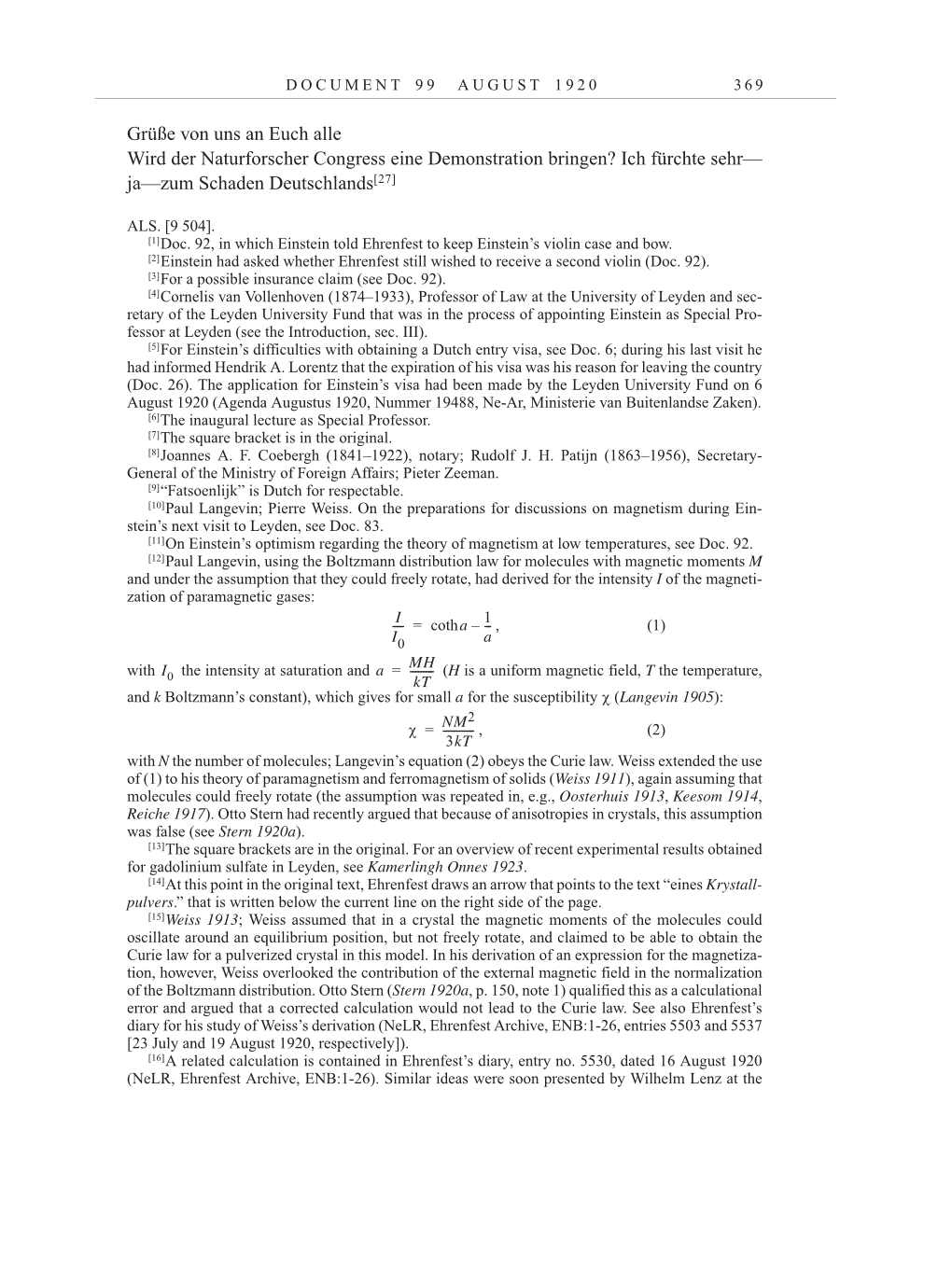D O C U M E N T 9 9 A U G U S T 1 9 2 0 3 6 9
Grüße von uns an Euch alle
Wird der Naturforscher Congress eine Demonstration bringen? Ich fürchte sehr—
ja—zum Schaden
Deutschlands[27]
ALS. [9 504].
[1]Doc. 92, in which Einstein told Ehrenfest to keep Einstein’s violin case and bow.
[2]Einstein had asked whether Ehrenfest still wished to receive a second violin (Doc. 92).
[3]For a possible insurance claim (see Doc. 92).
[4]Cornelis van Vollenhoven (1874–1933), Professor of Law at the University of Leyden and sec-
retary of the Leyden University Fund that was in the process of appointing Einstein as Special Pro-
fessor at Leyden (see the Introduction, sec. III).
[5]For Einstein’s difficulties with obtaining a Dutch entry visa, see Doc. 6; during his last visit he
had informed Hendrik A. Lorentz that the expiration of his visa was his reason for leaving the country
(Doc. 26). The application for Einstein’s visa had been made by the Leyden University Fund on 6
August 1920 (Agenda Augustus 1920, Nummer 19488, Ne-Ar, Ministerie van Buitenlandse Zaken).
[6]The inaugural lecture as Special Professor.
[7]The square bracket is in the original.
[8]Joannes A. F. Coebergh (1841–1922), notary; Rudolf J. H. Patijn (1863–1956), Secretary-
General of the Ministry of Foreign Affairs; Pieter Zeeman.
[9]“Fatsoenlijk” is Dutch for respectable.
[10]Paul Langevin; Pierre Weiss. On the preparations for discussions on magnetism during Ein-
stein’s next visit to Leyden, see Doc. 83.
[11]On Einstein’s optimism regarding the theory of magnetism at low temperatures, see Doc. 92.
[12]Paul Langevin, using the Boltzmann distribution law for molecules with magnetic moments M
and under the assumption that they could freely rotate, had derived for the intensity I of the magneti-
zation of paramagnetic gases:
, (1)
with the intensity at saturation and (H is a uniform magnetic field, T the temperature,
and k Boltzmann’s constant), which gives for small a for the susceptibility (Langevin 1905):
, (2)
with N the number of molecules; Langevin’s equation (2) obeys the Curie law. Weiss extended the use
of (1) to his theory of paramagnetism and ferromagnetism of solids (Weiss 1911), again assuming that
molecules could freely rotate (the assumption was repeated in, e.g., Oosterhuis 1913, Keesom 1914,
Reiche 1917). Otto Stern had recently argued that because of anisotropies in crystals, this assumption
was false (see Stern 1920a).
[13]The square brackets are in the original. For an overview of recent experimental results obtained
for gadolinium sulfate in Leyden, see Kamerlingh Onnes 1923.
[14]At this point in the original text, Ehrenfest draws an arrow that points to the text “eines Krystall-
pulvers.” that is written below the current line on the right side of the page.
[15]Weiss 1913; Weiss assumed that in a crystal the magnetic moments of the molecules could
oscillate around an equilibrium position, but not freely rotate, and claimed to be able to obtain the
Curie law for a pulverized crystal in this model. In his derivation of an expression for the magnetiza-
tion, however, Weiss overlooked the contribution of the external magnetic field in the normalization
of the Boltzmann distribution. Otto Stern (Stern 1920a, p. 150, note 1) qualified this as a calculational
error and argued that a corrected calculation would not lead to the Curie law. See also Ehrenfest’s
diary for his study of Weiss’s derivation (NeLR, Ehrenfest Archive, ENB:1-26, entries 5503 and 5537
[23 July and 19 August 1920, respectively]).
[16]A related calculation is contained in Ehrenfest’s diary, entry no. 5530, dated 16 August 1920
(NeLR, Ehrenfest Archive, ENB:1-26). Similar ideas were soon presented by Wilhelm Lenz at the
I
I0
----
1
a
-- - – cotha =
I0 a
MH
kT
--------- =
NM2
3kT
----------- - =
